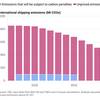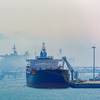The 5% Myth
Myth: 95-percent of the containers that come into the ports are not inspected.
Summary of Reality:
· The 95-percent figure is misleading and falsely implies that we do nothing to inspect cargo containers arriving at our seaports. We use intelligence to review information on 100 % of cargo entering our ports, and all cargo that presents a risk to our country is inspected using large x-ray and radiation detection equipment.
· Following 9/11, the Administration developed and implemented a smarter strategy to identify, target, and inspect cargo containers before they reach U.S. ports. While it is possible to secure a nation by closing its borders and inspecting everything and everybody that enters, doing so would render us obsolete.
· None of the security measures implemented as a result of this strategy existed before 9/11.
· Our strategy is to rule out potential threats before they arrive at our borders and ports. In fact, the security measures now in place allow us to rule out 94 % of the cargo as potential threats prior to its arrival into the United States. Six percent (6 %) of total cargo containers were identified this year as potential threats and were physically inspected immediately upon arrival. (The percentage will change annually because the inspections are based upon identified risk following intensive screening.) Dramatically increasing physical inspections after arrival is a waste of resources that will not appreciably increase our national security. In fact, the type of increase in physical inspections implied by this allegation would cost billions of dollars in resources and cripple not only the U.S. economy, but the global economy as well.
Key Facts Which Did Not Exist Before 9-11:
· The 95-percent figure is misleading and falsely implies that we do nothing to inspect cargo containers arriving at our seaports. We use intelligence to review information on 100 % of all cargo information entering U.S. ports, and all cargo that presents a risk to our country is inspected using large x-ray and radiation detection equipment.
·Following 9/11, under the leadership of President Bush we developed and implemented a smart cargo container security strategy to identify, target, and inspect cargo containers before they reach U.S. ports. Under this strategy:
1. 100 % of all containers identified as posing a terrorist risk are inspected using x-ray scans and radiation detection equipment. (i.e. anything identified as having the potential for concealment of terrorist weapons or terrorists.)
2. The Administration requires that advance information be given to our border agency, U.S. Customs and Border Protection (CBP), about all containers well before they arrive. In fact, the information is required 24 hours before they are loaded on to vessels at foreign seaports (24-Hour Rule).
3. Containers posing a potential terrorist threat are identified and targeted before they arrive at U.S. seaports by the National Targeting Center (NTC). The NTC was established as the centralized coordination point for all of CBP’s anti-terrorism efforts. Prior to 9/11, no national-level targeting of people or goods crossing our borders existed.
· NTC uses intelligence and terrorist indicators to review advance information for all cargo, passengers, and imported food shipments before arrival into the U.S.
· NTC coordinates with other federal agencies such as U.S. Coast Guard, Federal Air Marshals, FBI, Transportation Security Administration, and the Departments of Energy and Agriculture, as well as the intelligence community.
4. The Administration works with our foreign partners to allow U.S. officers working at major international seaports, currently 26, to identify and inspect containers prior to being loaded onto ships destined for the U.S. Container Security Initiative (CSI)
5. The Administration created a public-private and international partnership with over 7,000 businesses, including most of the largest U.S. importers -- the Customs-Trade Partnership Against Terrorism (C-TPAT). Under this program, legitimate companies that do regular business with the U.S. have increased their own security to prevent terrorists from infiltrating their shipments. (We check not only the company shipping the goods, but also the companies that provided them with any services.)
§ Approximately 40 % of all cargo headed for the U.S. is transported by C-TPAT partners and is therefore better secured.
· Additional technology has been added, including Radiation Portal Monitors, Isotope Identifiers, and Personal Radiation Monitors. For the first time CBP is also using chemical and explosive detector dogs to inspect cargo.
U.S. Customs and Border Protection (CBP) is the unified border agency within the Department of Homeland Security charged with the management, control, and protection of our Nation's borders at and between the official ports of entry. CBP is charged with keeping terrorists and terrorist weapons out of the country while enforcing hundreds of U.S. laws












